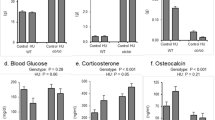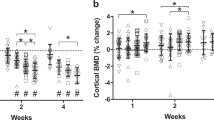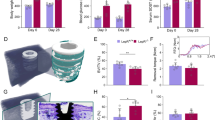Abstract
OBJECTIVE: To assess the effects of diet-induced obesity (DIO), on the biomechanical and biochemical properties of the femur in mature male rats.
DESIGN AND SUBJECTS: Two groups of male rats were studied. The DIO experimental group was fed a high caloric diet and a 31% sucrose solution as drinking fluid for a month, whereas the control group was fed lab chow and tap water.
MEASUREMENT: Body weight; body water; lean body mass; femoral length; average cortical thickness; outer anteroposterior diameter; outer mediolateral diameter; cortex area; moment of inertia; cortical and cancellous bone hydration; tendon and muscle hydration; ash content of cortical and cancellous bone; ultimate load; deflection at ultimate load; ultimate strength; stiffness; elastic modulus and energy absorption capacity.
RESULTS: ‘Gainers’ (final body weight in excess of three standard error of mean of the controls) were 19.1% heavier, with higher body fat, whereas body water, lean body mass, hydration of cancellous bone and ash content of cortical bone were lower, when compared to controls. Rats that failed to gain weight, despite the high caloric diet, were termed ‘resisters’ (weight gain less than three standard error of mean of the controls).
Ultimate load, deflection at ultimate load and femoral energy absorption capacity were significantly higher in the experimental group when compared to the controls. However, no differences were found among the groups with respect to ultimate stress and stiffness.
CONCLUSION: The weight gain produced by DIO may lead to bone adaptation and improved biomechanics.
This is a preview of subscription content, access via your institution
Access options
Subscribe to this journal
Receive 12 print issues and online access
$259.00 per year
only $21.58 per issue
Buy this article
- Purchase on Springer Link
- Instant access to full article PDF
Prices may be subject to local taxes which are calculated during checkout
Similar content being viewed by others
Author information
Authors and Affiliations
Rights and permissions
About this article
Cite this article
Brahmabhatt, V., Rho, J., Bernardis, L. et al. The effects of dietary-induced obesity on the biomechanical properties of femora in male rats. Int J Obes 22, 813–818 (1998). https://doi.org/10.1038/sj.ijo.0800668
Received:
Revised:
Accepted:
Published:
Issue Date:
DOI: https://doi.org/10.1038/sj.ijo.0800668
Keywords
This article is cited by
-
High Fructose and High Fat Exert Different Effects on Changes in Trabecular Bone Micro-structure
The journal of nutrition, health & aging (2018)
-
Impact of an obesogenic diet program on bone densitometry, micro architecture and metabolism in male rat
Lipids in Health and Disease (2012)
-
Changes in cortical bone response to high-fat diet from adolescence to adulthood in mice
Osteoporosis International (2011)
-
Effects of Diet-Induced Obesity and Voluntary Wheel Running on Bone Properties in Young Male C57BL/6J Mice
Calcified Tissue International (2010)



